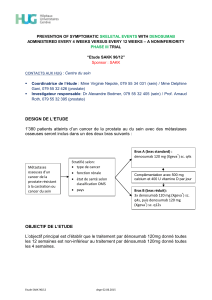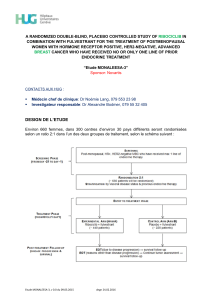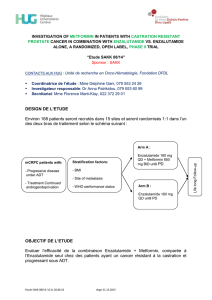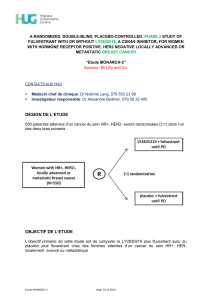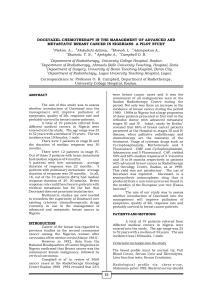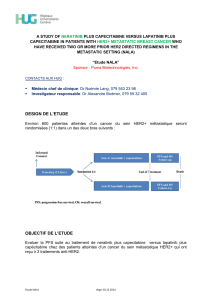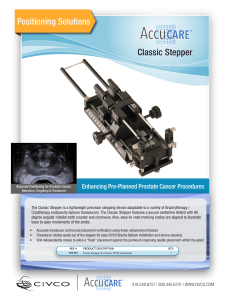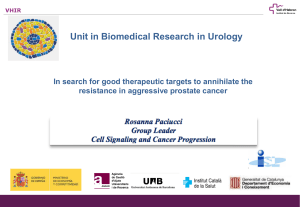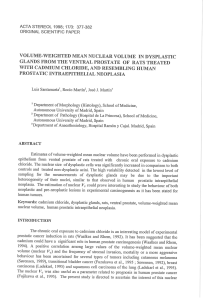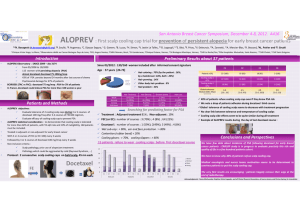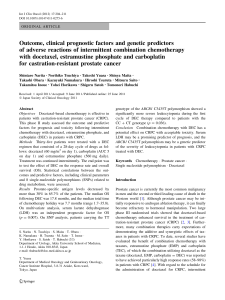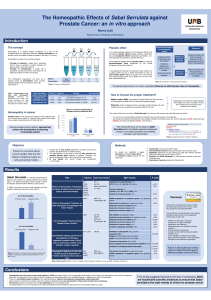Synopsis-type Présentation projet de mémoire de DES d’Oncologie
publicité
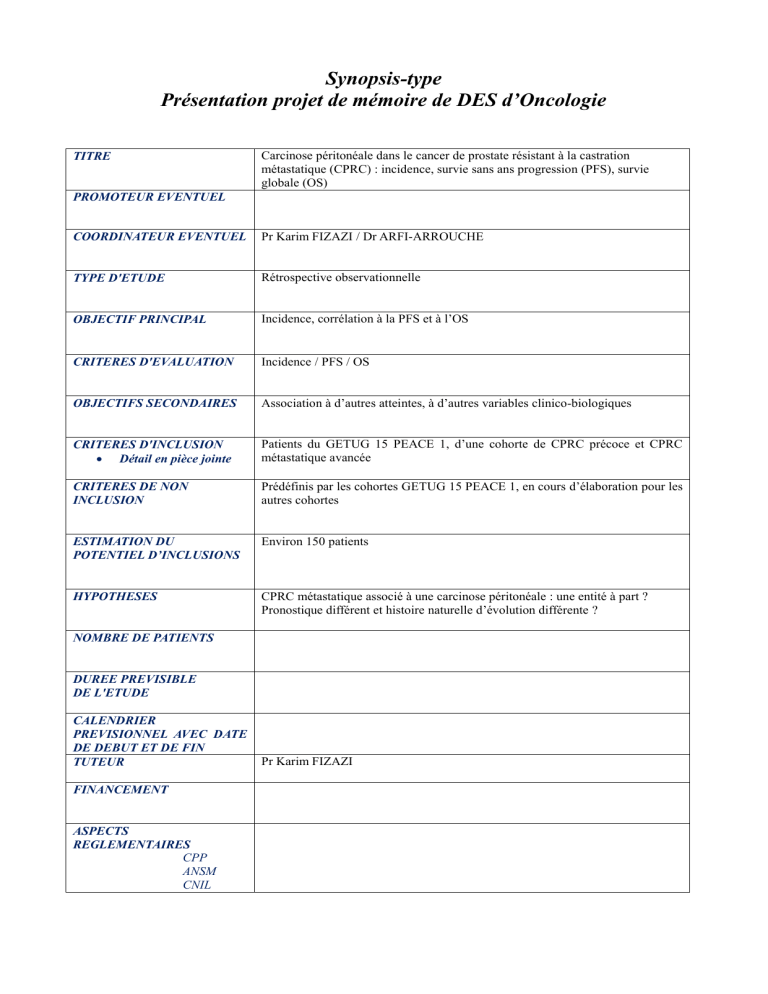
Synopsis-type Présentation projet de mémoire de DES d’Oncologie TITRE Carcinose péritonéale dans le cancer de prostate résistant à la castration métastatique (CPRC) : incidence, survie sans ans progression (PFS), survie globale (OS) PROMOTEUR EVENTUEL COORDINATEUR EVENTUEL Pr Karim FIZAZI / Dr ARFI-ARROUCHE TYPE D'ETUDE Rétrospective observationnelle OBJECTIF PRINCIPAL Incidence, corrélation à la PFS et à l’OS CRITERES D'EVALUATION Incidence / PFS / OS OBJECTIFS SECONDAIRES Association à d’autres atteintes, à d’autres variables clinico-biologiques CRITERES D'INCLUSION Détail en pièce jointe Patients du GETUG 15 PEACE 1, d’une cohorte de CPRC précoce et CPRC métastatique avancée CRITERES DE NON INCLUSION Prédéfinis par les cohortes GETUG 15 PEACE 1, en cours d’élaboration pour les autres cohortes ESTIMATION DU POTENTIEL D’INCLUSIONS Environ 150 patients HYPOTHESES CPRC métastatique associé à une carcinose péritonéale : une entité à part ? Pronostique différent et histoire naturelle d’évolution différente ? NOMBRE DE PATIENTS DUREE PREVISIBLE DE L'ETUDE CALENDRIER PREVISIONNEL AVEC DATE DE DEBUT ET DE FIN TUTEUR FINANCEMENT ASPECTS REGLEMENTAIRES CPP ANSM CNIL Pr Karim FIZAZI Critères d’inclusion et d’exclusion patients PEACE 1 Inclusion criteria : Histologically or cytologically confirmed adenocarcinoma of the prostate, Metastatic disease documented by positive bone scan or CTscan or MRI. For patients with nodal metastases only, only patients with extra-pelvic enlarged lymph nodes can be included if they have either: o At least one extra-pelvic lymph node ≥ 2 cm or o extra-pelvic lymph node (s) ≥ 1 cm if the patients also have at least one pelvic lymph node ≥ 2 cm Patients with ECOG ≤ 1 (PS 2 due to bone pain accepted), Life expectancy ≥ 6 months, Male aged ≥ 18 years old, Hemoglobin ≥ 10.0 g/dL, Platelet count ≥ 100,000/μL, Serum creatinine < 1.5 x ULN or calculated creatinine clearance ≥ 60 mL/min, Serum potassium ≥ 4.0 mmol/L, Serum bilirubin ≤ 1.5 x ULN (except documented Gilbert's disease); AST and ALT ≤ 2.5 x ULN (≤ 5 ULN in case of liver metastases), Patients might have received a maximum of 3 months of ADT before randomization, Patients might have received previous radiation therapy directed to bone lesions Patients able to take oral medication, Patients who have received the information sheet and signed the informed consent form, Male patients who are receiving the study treatment and have partners of childbearing potential are advised to use a method of birth control with adequate barrier protection (condoms) as determined to be acceptable by the study doctor during the treatment period and for 4 weeks after the last dose of the study treatment. Patients must be willing and able to comply with scheduled visits, treatment plan, laboratory tests and other study procedures, Patients with a public or a private health insurance coverage, o Additional criteria for patients receiving docetaxel: Patients willing to receive docetaxel Neutrophil ≥ 1500 cells/mm3 Liver function: AST and ALT ≤ 1.5 x ULN; ALP ≤ 2.5 x ULN; Serum bilirubin ≤ 1.5 x ULN. Male patients who will receive docetaxel and have partners of childbearing potential and/or pregnant partners are advised to use a method of birth control in addition to an adequate barrier protection (condoms) as determined to be acceptable by the study doctor during the treatment period and for 6 months after the last dose of docetaxel. Exclusion Criteria: Patients with previous local treatment directed to the prostate primary cancer. A previous TURP is allowed, Prior cytotoxic chemotherapy or biological therapy for the treatment of prostate cancer, Any chronic medical condition requiring a higher dose of corticosteroid than 5mg prednisone/prednisolone twice daily, Active infection or other medical condition for which corticosteroid use would be contraindicated, Previously treated with ketoconazole for prostate cancer for more than 7 days, Prior systemic treatment with an azole drug within 4 weeks of randomization, Uncontrolled hypertension (systolic BP ≥ 160 mmHg or diastolic BP ≥ 95 mmHg), Patients with a history of hypertension except if blood pressure is controlled by antihypertensive treatment, Active or symptomatic viral hepatitis or chronic liver disease (except Gilbert's disease), History of pituitary or adrenal dysfunction, Small cell carcinoma of the prostate, Clinically known significant heart disease (myocardial infarction, arterial thrombotic events in the past 6 months, severe or unstable angina,NYHA Class II-IV heart disease or cardiac EF < 50% at baseline, Atrial Fibrillation, or other cardiac arrhythmia requiring therapy, Other malignancy, except non-melanoma skin cancer, with a ≥ 30% probability of recurrence within 24 months, Known allergies, hypersensitivity or intolerance to the study drugs or excipients, Administration of an investigational therapeutic within 30 days of D1, Patients already included in another therapeutic trial involving an experimental drug, Patients with significantly altered mental status prohibiting the understanding of the study or with psychological, familial, sociological or geographical condition potentially hampering participation, Individual deprived of liberty or placed under the authority of a tutor. Additional criteria for patients receiving docetaxel: Patients with impaired vision should undergo a prompt and complete ophthalmologic examination. In case of Cystoid Macular Oeadema, the patient should not receive docetaxel. Concomitant use of strong CYP3A4 inhibitors (clarithromycin, indinavir, nefazodone, nelfinavir, ritonavir, saquinavir, telithromycin) 23. Allergy to taxane Critères d’inclusion et d’exclusion patients GETUG 15 Inclusion criterias: Prostate adenocarcinoma proven histologically Measurable or assessable metastatic disease Absence of previous chemotherapy for the metastatic prostate cancer Chemotherapy in an adjuvant or neoadjuvant situation or for elevation of PSA is accepted if it was ended more than a year previously, with evidence of absence of progress on the PSA or of appearance of metastases for more than a year. Adjuvant or neoadjuvant hormone therapy or hormone therapy for elevation of PSA is accepted if it was ended more than a year previously, with evidence of absence of progress on the PSA or of appearance of metastases for more than a year. Hormone therapy for the metastatic disease may have started but must not have been administered for more than 2 months on inclusion in the trial. Any radiotherapy on the sites of metastases must have been completed at the time of inclusion in the trial. Age ≥18 years ECOG ≤2 Estimated survival≥3 months Leukocytes ≥2000/mm polynuclear neutrophils ≥1000/mm Platelets ≥100 000/mm Liver function satisfactory: bilirubin, transaminases ≤1.5 times the upper limit of normal (2.5 x normal in cases of liver metastases). Renal function satisfactory: serum creatinine ≤150 μmol/l Information for the patient and signature of the informed consentment. Exclusion criterias: Severe cardiovascular disease (symptomatic coronary disease, congenital heart failure, classes 3 and 4 of the NYHA classification) Severe peripheral neuropathy Active infection or other serious underlying disease which may prevent the patient from receiving the treatment A history of cancer in the 5 years prior to inclusion in the study, other than treated basocellular cutaneous cancer Patients who have had surgical castration Symptomatic or asymptomatic cerebral metastases which are not under control A patient taking part in another therapeutic trial protocol with an experimental compound during the present study A history of or ongoing progressive psychiatric disease Impossibility of giving informed consent Impossibility of undergoing medical follow-up forgeographical, social, or psychological reasons A patient protected by law

